Most attorneys understand that marketing is necessary, but figuring out exactly how much to spend can be confusing. A law firm marketing budget is impacted by various aspects, like firm size, market competitiveness, and growth objectives. There’s no single formula that works for everyone.
So many things have already been said about the best marketing channels and their effectiveness. But beyond the decision on the most successful marketing strategy, what matters (and often becomes a critical factor) is how much to spend on it. That’s what this guide is about: the factors that affect your budget and how to come up with the best budget plan possible.
- How much a law firm spends on marketing depends on its revenue, size, competition, and future plans.
- Common marketing goals are increasing brand awareness, acquiring new clients, retaining existing clients, and entering a new target market.
- Digital marketing typically takes the largest portion of law firm marketing budgets.
- Google Ads provides fast results but can be expensive, as some legal keywords cost over $200 per click.
- SEO and content marketing are cost-effective strategies but typically take between six months to a year to show strong results.
How Much Do Law Firms Spend on Marketing?
The average marketing budget of law firms takes around 2% to 5% of their revenue. For some, it can go up to 20%, depending on their size and what they aim to achieve.
When it comes to a marketing budget for a small law firm, it can be between $3,000 and $6,000 per month. They usually focus on basic digital marketing strategies, like Google Business profile optimization and Facebook and LinkedIn marketing.
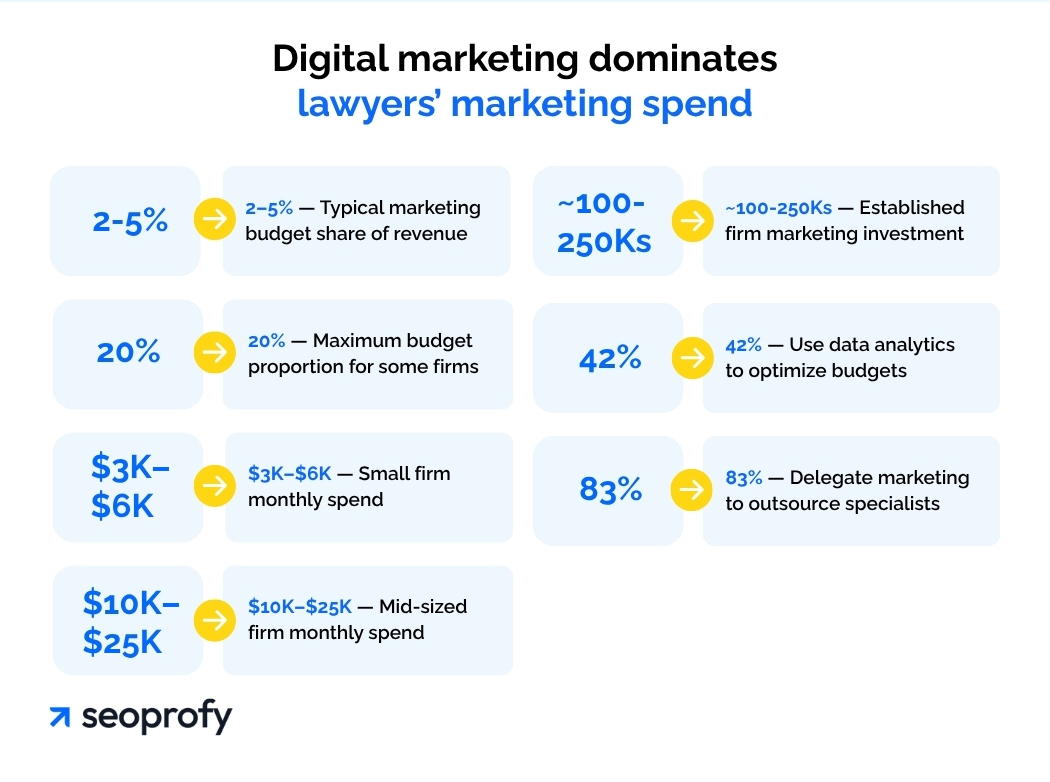
Mid-sized firms tend to spend more, and their budget may reach from $10,000 to $25,000 a month. They often run multiple campaigns across different channels, like search engine optimization (SEO), digital ads, and even some traditional media. Established firms can invest hundreds of thousands each year in marketing initiatives, and returns often make it worthwhile.
If you look closer at how these budgets are allocated, digital marketing usually takes the largest piece of the pie. After all, people might hear about you anywhere, but their buyer journey almost always ends up in the digital space.
Around 42% of attorneys base their budgets on data from reporting tools. The metric analysis allows for detecting the most effective marketing channels and redirecting the budget there next time.
Another law firm marketing spending trend to consider is that 83% of law firms choose to hire external specialists. This lets lawyers focus on being lawyers instead of trying to be marketers, too, or managing their in-house team. And, of course, further tracking their marketing performance is crucial for effective lead generation for lawyers.
The Key Law Firm Marketing Spends
When you start planning your law firm marketing budget, it all begins with clear, well-defined goals. Before resorting to specific tactics like SEO or online ads, you should be sure about what you want to achieve:
- Increasing brand awareness: Before someone becomes your client, they need to know you exist. Firms invest in targeted ads and thought leadership content to get their name noticed.
- Client acquisition: Attorneys might invest in Google Ads, create detailed content about their practice areas, and ensure their law firm website shows up when potential clients search for legal help.
- Customer retention: Clients already trust you, and they might need legal services again someday. To improve the experience of current clients, law firms might set up client portals to simplify document sharing or host educational webinars about new laws that affect their clients’ businesses.
- Entering new markets or adding practice areas: Maybe you want to add a new legal practice area or open a new office in a different city. Here, you have to begin from scratch, build credibility, and understand how to connect with a new audience in the most effective way. You’d need to research the new market, launch targeted advertising in the new location, and create new content that addresses the pain points of your new prospective clients.
- Market and competitor research: Firms also often analyze what services their competitors advertise, how much they charge, and how they market themselves overall. Some even hire research agencies to survey potential clients about what they look for in a lawyer. Others analyze market trends to find gaps in the area and take advantage of them.
How to Figure Out Your Law Firm Marketing Budget
After discussing your goals, let’s discover what influences your law firm marketing budget. Here are a few main factors that affect these decisions:
- Revenue: Everything starts with your current revenue. And it’s about practical thinking since your marketing investment needs to match what your firm can sustain. You can always increase your spending once you see positive results.
- Firm size: Smaller firms often need to allocate a bigger percentage of their revenue to marketing compared to larger ones. That’s because they’re often up against larger competitors with more resources and an established reputation.
- Your market: If you’re working in a busy city area with lots of other firms, you’ll likely have to spend more to stay afloat. But if you’re the only family law firm in a smaller town, your marketing costs might be much lower.
- Goals: If you’re happy with your current client flow and just want to maintain your brand visibility, you might only need a small budget: some social media, maybe a newsletter. But if you aim for growth, your budget should reflect these ambitions and support your plans.
Law Firms Marketing Channels
Your leads search for legal help in different ways. Some turn to Google, others ask friends for recommendations, and many check social media. That’s why it’s so important to understand what the most appropriate marketing channel is to invest in, particularly for your law firm. Here are the most popular channels among both attorneys and clients (you don’t have to pick only one):
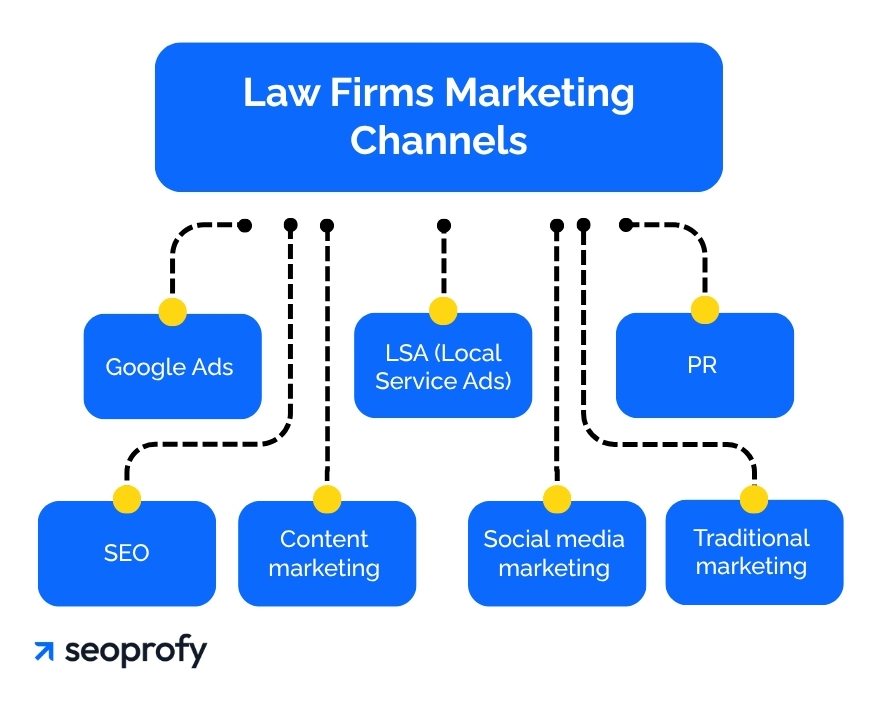
- Google Ads: This is often the fastest way to reach the right prospects. Yet, this method is quite expensive, especially for legal keywords. About 97% of law firms using Google Ads confirm that the cost per click is high, which makes it challenging to see a good return. Some firms can even spend more than $200 per click in competitive markets. As the screenshot below shows, the cost per click for some high-value keywords, like “car accident lawyer,” can reach $357.80.
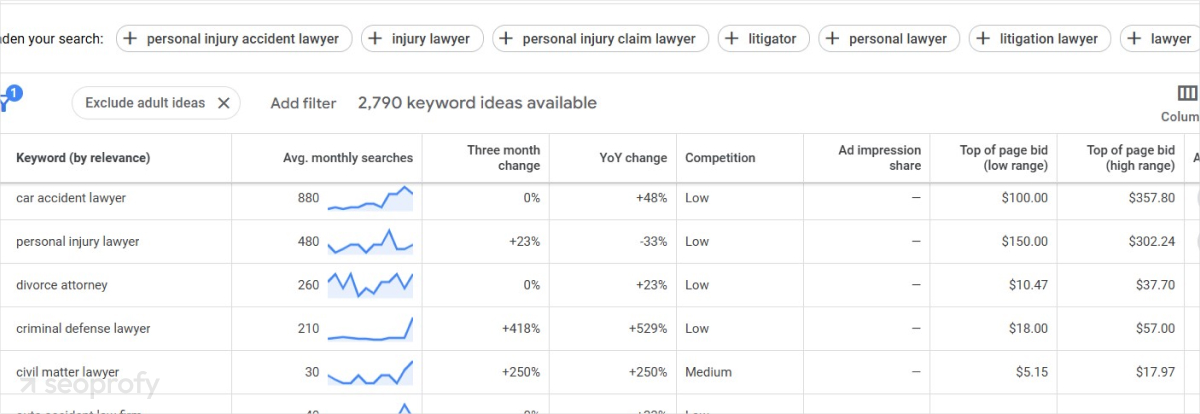
- Local Service Ads (LSA): This type of paid ads is particularly important for businesses with physical locations to reach customers in their service area. In contrast to Google Ads which operate on a pay-per-click model, LSA utilizes a pay-per-lead. LSAs are highly effective for law firms because when someone searches for legal services in their area, these ads are the first results they see.
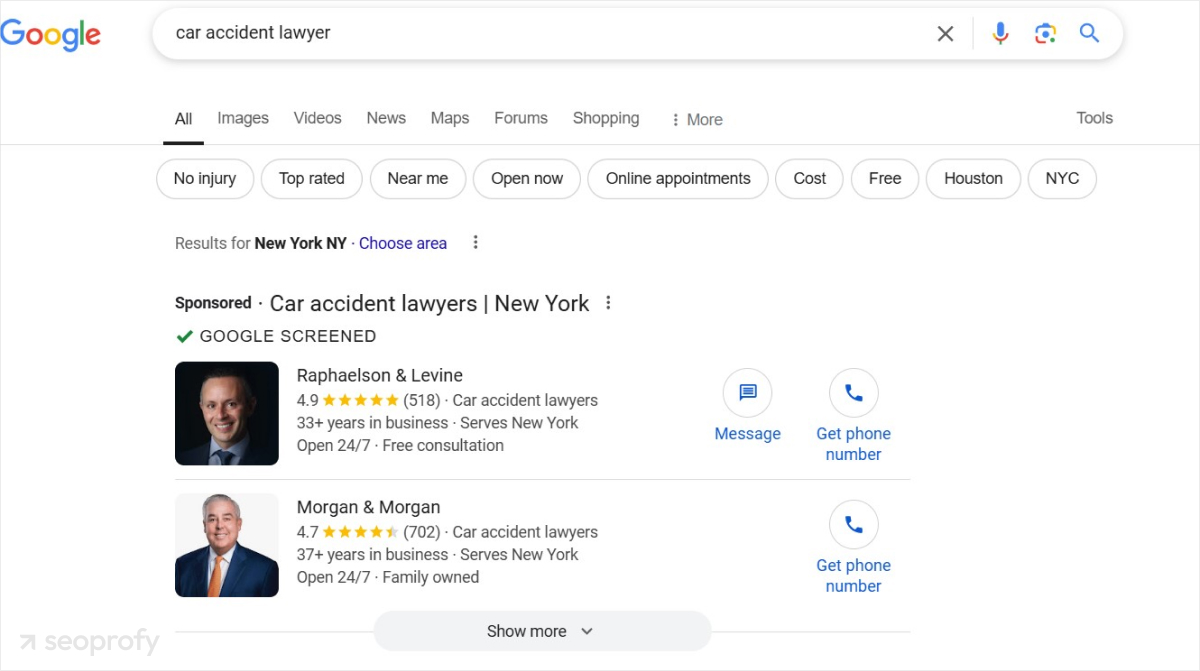
- SEO: Around 90% of marketers said SEO helped boost their website results and reach their marketing goals. Once you rank well, you’ll receive leads without having to pay for each click. Yet, results usually take about 6 to 12 months, and you need to adjust your SEO strategy according to ever-changing Google algorithms.
- Content marketing: Blog articles, landing pages, and videos are another long-term strategy. Helpful legal content positions you as an expert and also strengthens your SEO best practices. Plus, once you create good content, it will keep working for you for years.
- Social media marketing: Platforms like LinkedIn work well for B2B law firms and professional networking, while Facebook can be effective for attracting B2C clients. It’s relatively affordable and helps show the human side of your firm. Yet, just like with SEO for lawyers and content marketing, building a following takes time.
- Traditional marketing: Old-school methods like local radio, billboards, and print ads still have their place. Plus, they reach people who might not be active Internet users.
- PR: Anyone can buy an ad, but getting quoted as an expert in your local paper or speaking at an event can be harder and, thus, allows you to create truly authentic connections in your local community.
Ready to attract more of your ideal clients through Google? SeoProfy helps law firms:
- Rank for valuable legal search terms in your area
- Increase visibility for your key practice areas
- Convert more website visitors into qualified leads

Pricing for Marketing for Law Firms
Each marketing channel we’ve discussed above implies costs that might not be obvious from the outset. The expenses go beyond just paying for ads or creating content.
The more thorough your budget planning is now, the less likely you’ll have to pause campaigns because funds run out unexpectedly. Let us break down what you should plan for:
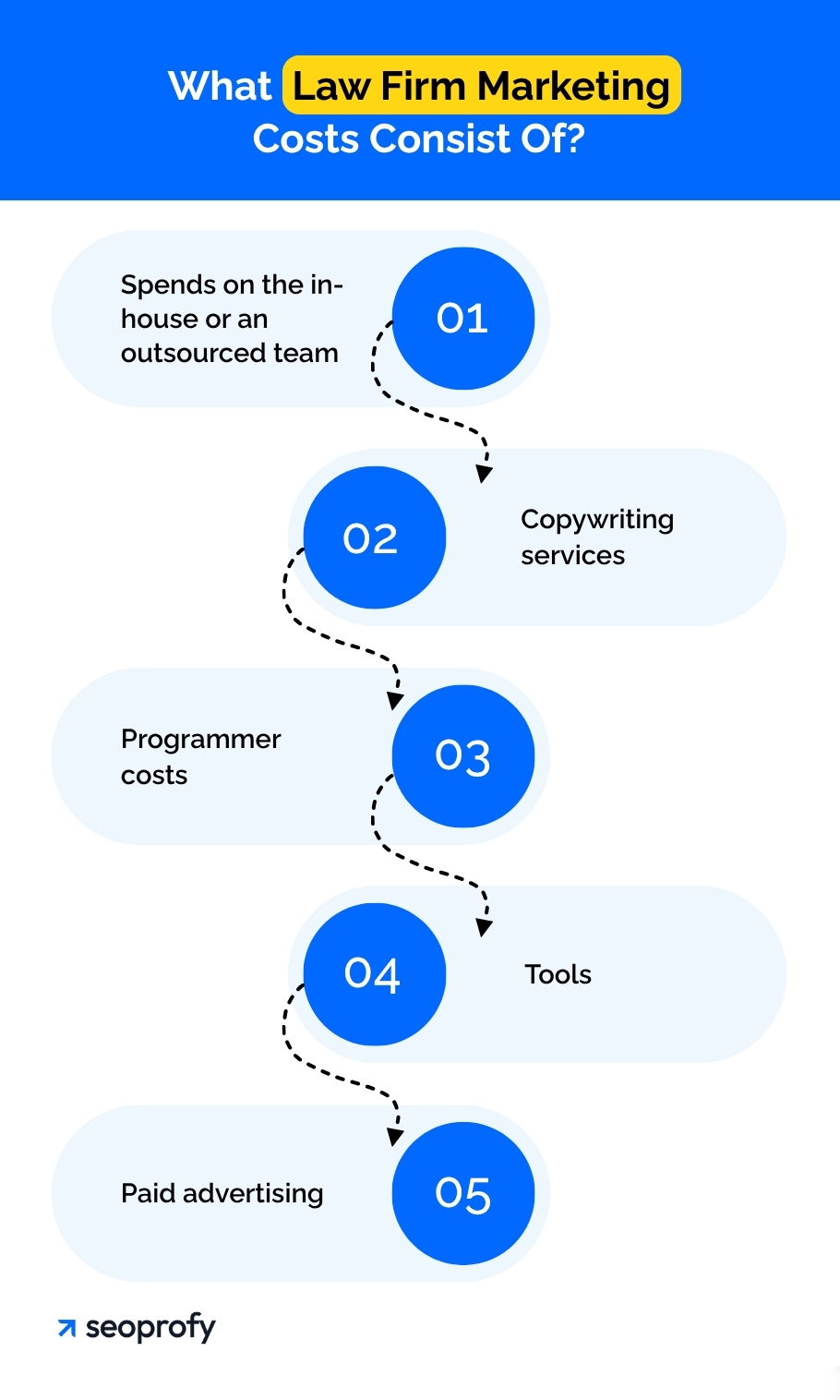
- A marketing team: Whether it’s an in-house marketing team or an outsourced agency, talented people who bring measurable results don’t come cheap. Some firms start with contractors to test the waters before committing to full-time hires. Some prefer to combine external expertise with internal employees. The most important thing is to have someone who understands the legal industry and your field of law well.
- Copywriting services: Creating good legal content requires expertise, and a blog article can cost from $150 to $500. Yet, you’ll also need newsletters to keep your clients updated, social media posts, case studies to display your results, and maybe even videos. Plus, your writers should understand both law and marketing.
- Programmer costs: Every change or fix on your website must also be considered. You might need to publish landing pages for new practice areas, updates to your attorney profiles, security patches, or any site speed improvements.
- Tools: You might need an SEO platform to track rankings and research keywords. Then there are social media scheduling tools, email marketing, analytics software, and much more. Together, these tools can easily add up to over $1,000 a month. Here’s a tip: working with a marketing agency can save you money because they usually have access to premium tools included in their service price. What’s more, the best law firm SEO companies, like SeoProfy, even have custom software that gives you an edge over firms relying on standard platforms.
- Paid advertising: Lastly, law firm advertising isn’t just about the ad spend. Besides paying for clicks, you should invest in ad design and copywriting, as well as in creating effective landing pages to turn visitors into clients. Campaign management, like testing different ads and adjusting targeting, must also be taken into account.
How to Create a Law Firm Marketing Budget
So, we’ve laid out all the aspects that can influence a marketing cost for an attorney. And now we’ve come closer to the main question: how do you turn this into a budget that aligns with your resources yet helps you get clients for your law firm? Here are some tips that will help you strike a balance.
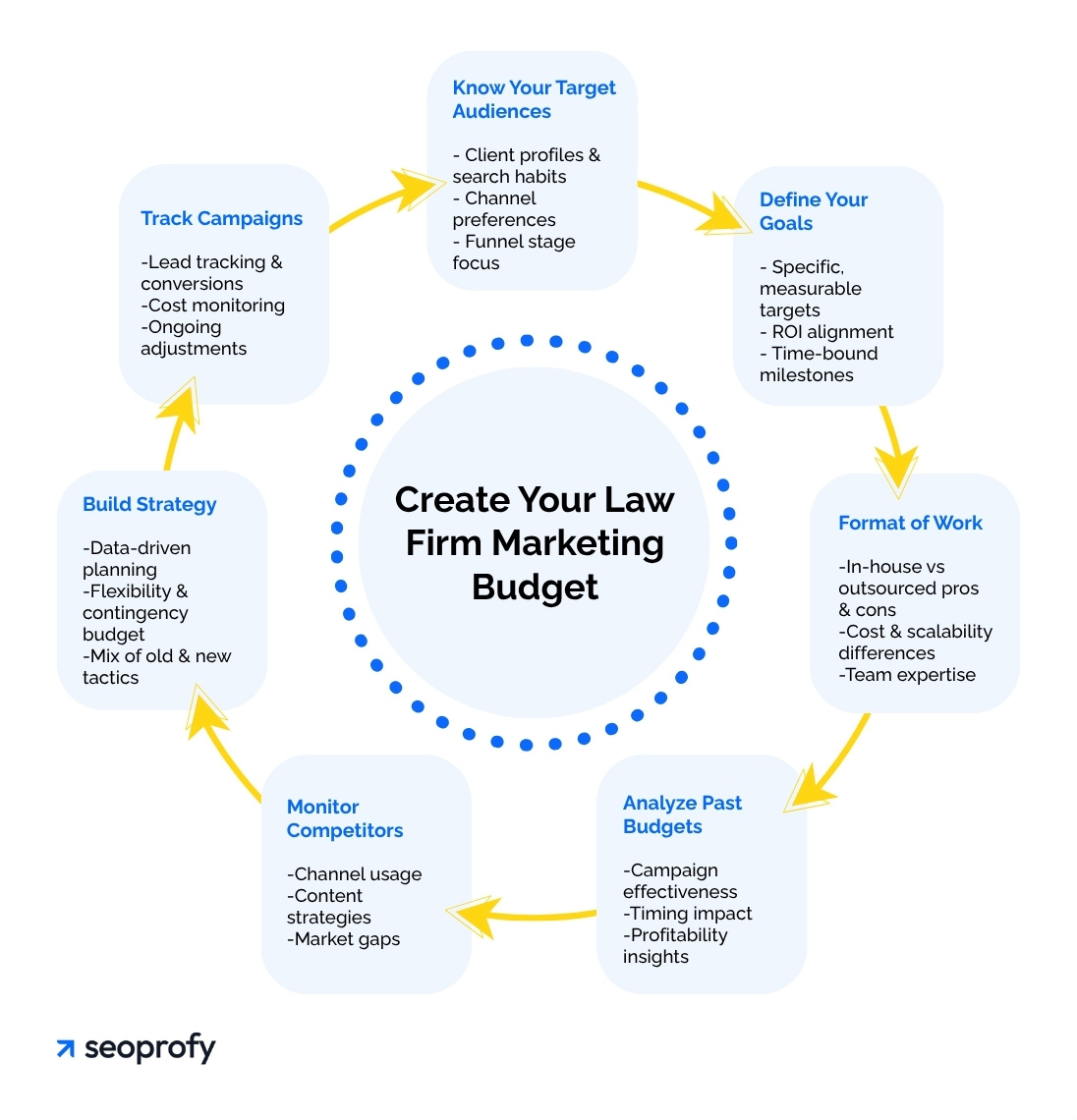
Know Your Target Audiences
Before you spend on marketing, make sure you have a clear picture of your target clients. It’s easy to waste money when you’re not sure who you want to reach. But focused efforts save a marketing budget for a law firm.
First of all, assess the clients you already have and who bring in the most value. Identify their demographics and engagement patterns. You might ask yourself the following questions:
- When do they search for legal help? You might notice a spike in personal injury leads after weekends or holidays.
- Where do they go online for information? You may ask your current clients about the channels where they found you.
- What challenges do they face? Some prospects might be interested in their next steps after a car accident, while others might have been offered a quick settlement and wonder whether it’s fair.
The answers to these questions will give you an understanding of the marketing channel and content to invest in. Also, consider where people are in the marketing funnel. Some are just browsing to check their options, while others are ready to hire you here and now. Your legal content writing strategy should address both types.
And here’s how Michael Kelly Injury Lawyers address them. In the first screenshot, you can see content that mostly targets people who may not yet realize they need an attorney. They just got into an accident and wonder what their next steps are:

But the page below targets those who are already considering hiring a lawyer and are curious about potential expenses:
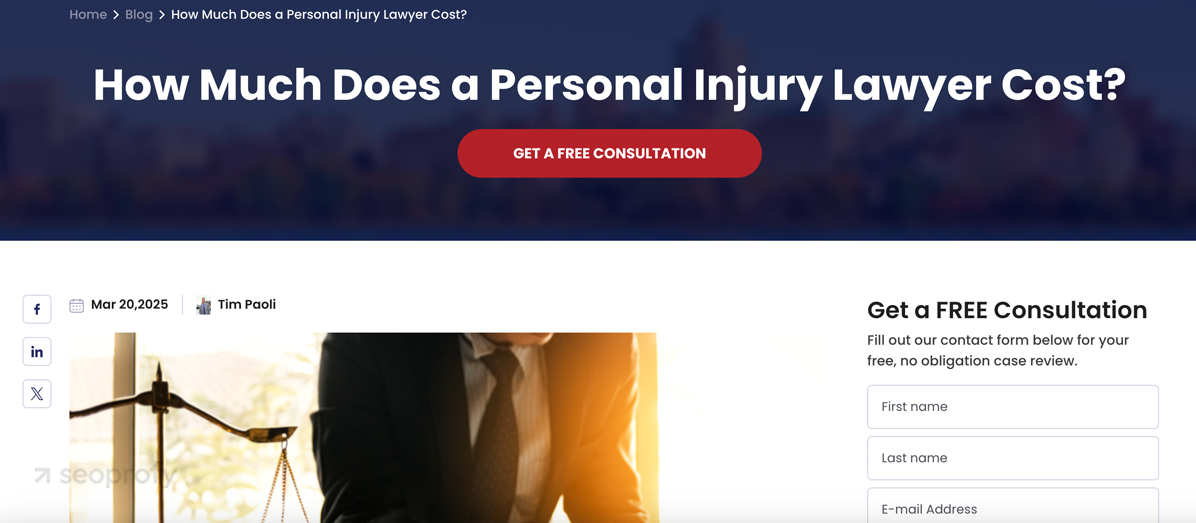
Your understanding of your potential clients should improve over time. That’s why it’s also necessary to keep track of who responds to your marketing and who becomes a client.
Define Your Goals
Simply saying you want “better visibility” isn’t specific enough to plan your budget. It’s much better to turn your goals into something measurable and achievable.
When you just aim for more visibility, it’s harder to define which actions can help you achieve this goal and understand that you’ve actually reached it. So, instead, consider setting a goal of “ranking in the top three results on Google for ‘family lawyer in [your city] until the end of this year’” or “increasing bookings by 25% this quarter.”
These are clear and time-bound goals you can track. Time-bound goals can also better align with your budget planning, as you can match your law firm marketing spending to specific fiscal periods.
And don’t forget to connect your goals to revenue. If an average law firm’s marketing budget is $5,000 a month, you need to know exactly what kind of marketing ROI you want to see to make it worth it. Here’s how you can calculate ROI:
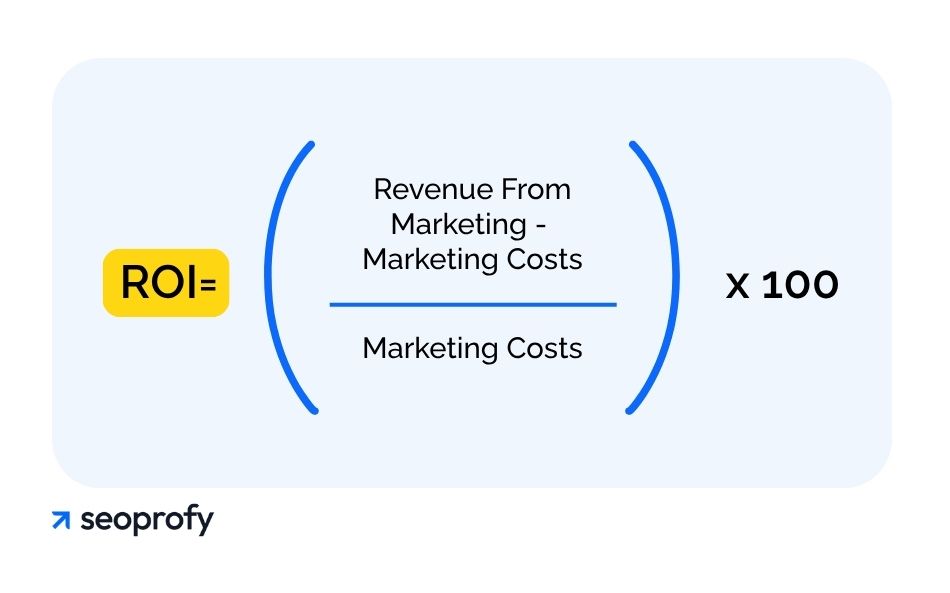
Determine the Format of Work with a Marketing Team
There are two main options: building an in-house team or hiring an external marketing agency. When it comes to an in-house team, consider that you’re not just paying salaries. You also have to factor in benefits, training, and all the marketing tools and subscriptions mentioned earlier. Plus, with an in-house team, the fixed law firm marketing cost you pay stays the same whether you run big campaigns or not.
Conversely, when you work with a law firm SEO company, you can usually increase or decrease your spending depending on what’s required each quarter. Unless your firm is huge and needs full-time, ongoing marketing support, outsourcing tends to make more financial sense.
|
Cost Factor |
In-House Marketing Team |
Outsourced Marketing Agency |
| Core expenses | Full-time salaries, regardless of workload | Pay only for the services needed |
| Employee benefits | Health insurance, paid vacation days, and sick leaves | Included in agency fees |
| Software & tools | Have to pay for all marketing tools | Included in agency fees |
| Expertise access | Limited to the hired team’s knowledge | Access to diverse specialists across multiple disciplines |
| Scalability | Fixed costs regardless of campaign volume | Pay only for what you need when you need it |
| Professional development | Ongoing training expenses | Agency handles its own staff development |
| Team turnover | Rehiring and retraining costs | Agency handles its own staffing issues |
Analyze Previous Marketing Budgets and Results
Your past marketing efforts, whether they were successful or not, can give you a hint on where to focus your law firm marketing budget next. Begin by checking what campaigns you have run and extracting the numbers. Evaluate your website costs, ad spending, event sponsorships, and other expenses and match them against your results.
This will help you determine whether your monthly lawyer PPC campaign generates enough consultations or whether your recent website redesign has actually improved your conversion rate. And that’s how you find out what’s worth investing in again.
Pay attention to timing, too. Otherwise, you may get frustrated that your campaigns didn’t work out. But what if you just didn’t give them enough time? For instance, SEO might look expensive at first glance if you only assess three months of costs, but check a full year’s results, and you might see it’s your best performer.
Additionally, consider what worked for different types of clients. For example, your recently published service page might not have brought in many clients overall, but it may have attracted your most profitable cases. That’s worth knowing before you cut content marketing from your next budget.
Monitor Competitors’ Marketing Strategies Research
Monitoring how your competitors approach legal marketing is another way to come up with a precise and, most importantly, effective budget plan. You could track what channels they use most often.
If you notice they are suddenly very active on LinkedIn, there’s probably a reason, and this reason is worth investigating. If you reveal that LinkedIn marketing works for other law firms in your town, it might work out for you as well. This is how you can invest your money in the right channels and avoid wasting it through trial and error.
Your rivals’ content strategy also matters. The topics they cover and how often they post will give you a solid idea of what you’ll need to invest in content to stay competitive. Plus, sometimes, you may come up with topics they miss, which will give you an edge.
Build a Strategy
This is where everything we’ve discussed comes together: your past results, competitor insights, and the goals you’ve set. With all of these factors in mind, you’re free to start creating a law firm marketing budget. Let’s sum up what a solid plan usually includes:
- Marketing channels you know work
- New market opportunities you could benefit from
- Basic activities to keep your current clients happy
- Fresh ideas you want to test
It’s also essential to stay flexible with your plan. Markets change, new opportunities arise all the time, and sometimes, what worked before stops being effective. Consider also preserving around 10-20% of your law firm marketing budget so you can be ready for any unexpected expenses.
Track Your Marketing Campaigns
So, as we’ve already found out, monitoring your previous marketing campaigns and the amount spent helps determine where to invest next. Keep it up, and continue tracking all your future campaigns. Here are some core aspects to monitor:
- Where your leads come from
- How many consultations become clients
- Which channels bring your most valuable cases
- Your customer acquisition cost
- How long different campaigns take to show results
Regular tracking allows you to detect problems. If your SEO traffic drops or your ad conversions slow down, you’ll be able to quickly make adjustments, saving money and effort. Weekly reviews are great for identifying quick wins and fixing issues, but you could conduct deeper reviews every few months to understand overall trends and progress.
SeoProfy Helps with Scaling Your Law Business
If you want to connect with potential clients, your law firm’s spend on marketing doesn’t always have to be the biggest among your rivals. All it takes is just thoughtfully approaching your budget planning. A thoughtful approach is about understanding your audience, knowing the pros and cons of each marketing channel specifically for you, and setting clear, realistic, and measurable goals for each marketing campaign.
Another important part of smart marketing budget planning is accepting that not every campaign will be successful, and that’s okay. Good marketers see failures as chances to learn and improve for next time.
However, why take extra time to learn from your own mistakes when you can start with proven strategies? With SeoProfy, a professional SEO agency, you can avoid costly marketing failures.
Our SEO case studies show the real results we deliver. We do a thorough SEO audit, create a custom plan based on your practice areas, conduct detailed keyword research, and create engaging content that speaks to your potential clients. Plus, we use our own specialized SEO tools, so you don’t have to pay for any extra subscriptions.
Get in touch with SeoProfy today for a free consultation and find out how we can help you build a strong online presence that brings in quality clients now and for years to come!













